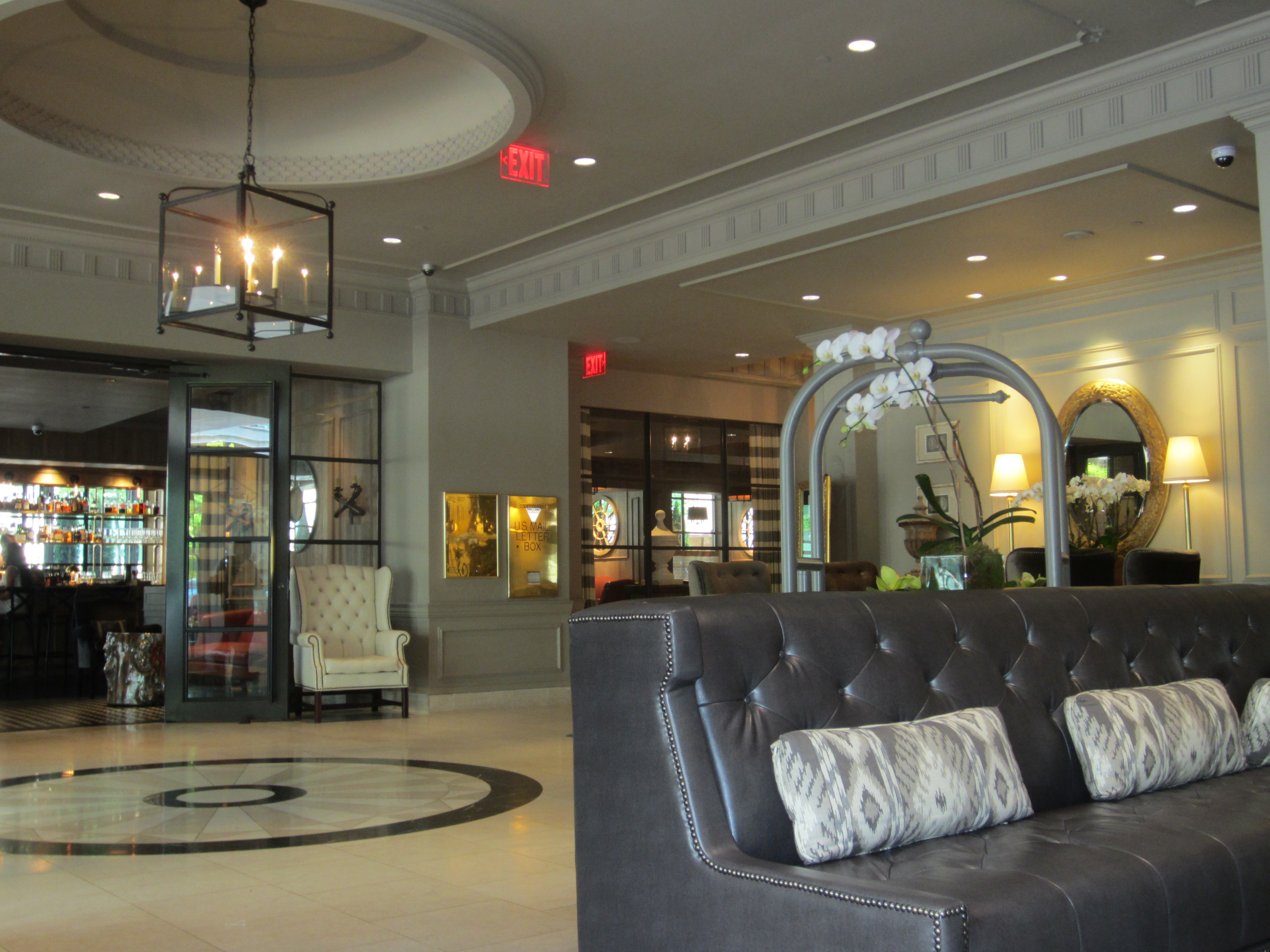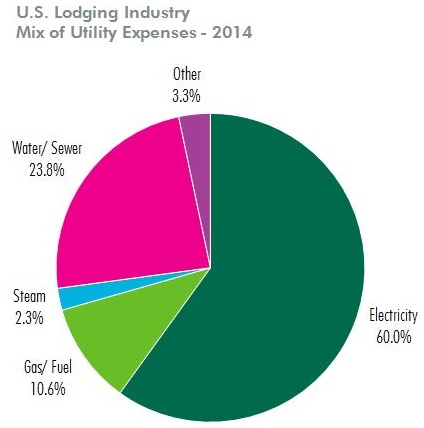Hotels service a high volume of guests, all with varying needs. Guest satisfaction is one of the most important factors in running a successful hotel. The majority of guests are on business or vacation and seek a hotel experience where they will feel comfortable and pampered. As a result, guests pay no mind to leaving lights and air conditioning units on throughout the day, as they are not charged for the additional expenses and it adds to their overall comfort level. This presents an issue, as electricity accounts for 60 percent of an average hotel’s total energy expenditure, and utility prices are on the rise.
Source: CBRE Consumption and Pricing Influence Hotel Utility Costs
Per occupied room, hotels in New England are the second most expensive to operate in the U.S. Managing the guest experience while combating energy costs, therefore, continues to be a challenge. As a sound business practice, leaders in the hotel industry have taken great strides in installing energy efficient equipment to minimize costs without impacting the guest experience. However, new solutions continue to develop, and measures that were installed only a few years ago could now be outdated or in need of a fine tune-up. Let’s examine the current best practices in energy efficiency and investigate how they can reduce hotel energy costs.
Thermostat Controls
One of the major problems hotel managers experience is guests adjusting temperature settings to leave air conditioning units on throughout the day, even when they are not occupying the room. A few methods have been developed to tackle this challenge, including keycard holder systems and guest presence detection sensors.
Keycard holder systems, when synced with the building management system (BMS), gives information to the BMS on whether the room is occupied or unoccupied, which can trigger the HVAC unit to call for different heating or cooling cycles based on temperature setpoints. For example, a best practice would call for higher temperature setpoints in the summer while the room is unoccupied, to avoid unnecessary cooling. When a guest returns and the keycard is inserted for room access, the HVAC will begin a cooling cycle at a lower temperature setpoint to ensure guest comfort. A common drawback to the keycard holder system is that some can be bypassed by leaving a spare keycard in the holder to trick the BMS into thinking the room is occupied.
Guest presence detection sensors are a more advanced system using motion control and door sensors. The sensors provide information to the BMS in the same manner that a keycard holder system does. An advantage of motion and door sensors is they cannot be bypassed. Additionally, they provide comfort and energy consumption data to the BMS, which can be leveraged to improve the guest experience moving forward.
Lighting Controls
As is the issue with thermostat control adjustments, guests have a habit of leaving lights on all day. Installing lighting sensors and controls will turn lights on or off automatically, depending on the room’s occupancy. Installing lighting control sensors is also an excellent strategy to incorporate throughout the entire hotel, especially for areas that do not see a lot of foot traffic.
Simultaneous Heating & Cooling
A major—and very common—energy waste for hotels is simultaneous heating and cooling. Simultaneous heating and cooling, as it sounds, occurs when the air handling unit (AHU) calls to both heat and cool the room at the same time to reach an ideal temperature and relative humidity (RH).
AHUs bring in fresh, outside air into the building and heat or cool that air depending on the need. As the seasons change, the outside air temperature will change. Creating a balance between the temperature of the fresh air brought in by the AHU and the heating and cooling cycles can help minimize the amount of air that needs to be conditioned to maintain comfort levels. Installing a demand control ventilation (DCV) system with an economizer can help reduce energy consumption by up to 50 percent every year.
We discuss how a DCV systems works in more detail in our section regarding kitchen energy management below.
Kitchen Energy Management
Hotels have active kitchens, especially those that offer 24-hour room service. A common issue that comes with that territory is a lot of wasted energy from kitchen hoods. On average, kitchen exhaust hoods exchange the air 15-20 times per hour to remove smoke, dust, and other air pollutants. About one-fourth of the system’s energy is consumed during this air exchange phase. Solutions include installing a DCV system and a variable frequency drive (VFD).
Demand control ventilation
Buildings require a certain amount of fresh, outside air to ensure good indoor air quality (IAQ). Typically, ventilation standards are set at the building’s maximum occupant capacity; however, buildings are rarely at full capacity, meaning more energy will be consumed to ventilate the air than necessary. A DCV system solves this by adjusting the amount of fresh air brought into the building based on the occupancy of the space. Installing a DCV system can effectively reduce energy consumption between 30 to 50 percent.
Variable frequency drives
A VFD is multi-purpose control that can be applied to many operating processes to reduce energy costs. In commercial kitchens, a VFD detects the temperature, smoke, and/or air quality using sensors installed within the exhaust hood and the AHU. A VFD works well in conjunction with a DCV system, as VFDs adjust the speed of the fan motor, based on the need, to help ventilate unnecessary air pollutants to improve the kitchen’s air quality.
Chiller Efficiency
Chillers are the largest energy consuming and most expensive piece of equipment within most mid- to large-size commercial and industrial facilities. A commercial chiller can consume between 35 to 50 percent of a building’s annual electricity use, and an inefficient chiller can waste up to 30% in energy expenses. A variable frequency drive and load reduction strategies can help reduce energy inefficiencies.
Variable frequency drive
Chillers rarely run at maximum cooling capacity, but the chiller’s compressor will run at full speed regardless of the cooling capacity need. Similar to other equipment, we find ourselves wanting to install a VFD. In chiller applications, a VFD will vary the speed of the motor on the compressor based on the load capacity requirements, which will save a significant amount of energy.
Load reduction
Reducing load requirements is a more comprehensive energy efficiency approach. The more work (load) chillers have, the more energy will be consumed. Reducing load requirements effectively saves energy. By making the entire hotel more energy efficient through BMS management, HVAC controls, lighting & lighting controls, water conservation, building envelope improvements, and other energy management strategies, the chiller load will be reduced.
Bottom Line
Hotels have a complex set of energy management needs. Hotel managers must constantly evaluate new solutions that improve hotel energy efficiency without disrupting the guest experience. By examining some of the larger energy efficiency challenges, including various lighting and temperature controls, simultaneous heating and cooling, kitchen exhaust hoods, and chillers, managers can curb hotel energy costs. Furthermore, by improving the efficiency of many of these processes, the lighting and comfort conditions throughout the hotel will be enhanced, which can positively impact the guest experience.





